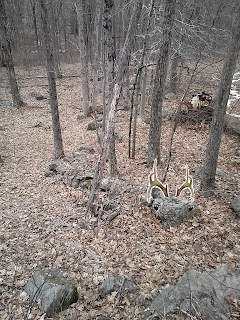"What would you name this rock formation? You can see it on the George and Rosemary Moore Trail/red trail in Jewett Preserve. The ribbon cutting for the opening of the trail is Sat. Dec 1 at 10am at the Mt Archer Woods parking lot. Click on the link below for more info:
Medicine for Salmon
Except for those used in World Renewal rituals, only four spoken formulas for taking salmon have been documented, and (probably by coincidence) all four were collected from Yurok speakers shortly after 1900.
A formula from Stone of Weitchpec (Yurok) called upon a wo'gey who had spoken with Nepewo (The Great Head Salmon). He asked him for salmon and other things. Although he held a spear, he did not attempt to strike Nepewo, who listened and then went on his way. After that, the spirit-person always found salmon and killed them easily. The wo'gey who is called upon in this formula instructs the fisherman to "talk to his harpoon" (that is, speak the formula over it) and dictates various restrictions that the fisherman had to observe in order to preserve his luck (appendix 2, C-7).
― 164 ―
The second formula for salmon, collected from Billy Werk of Weitchpec, was used with a song. The narrative involved a story about Small Salmon (Tserhkr). He followed some other fish into a sweathouse, even though the owner told him that there was no room to lie down there. He found himself a place anyway and sang a certain song. This formula and song were to be used while the fisherman tied the webbing to the frame of his dipnet rather than after he had started fishing (appendix 2, C-8).
Another Yurok known as Lame Billy of Weitchpec had a formula for salmon involving Coyote, who pretended to be a Karok person traveling upriver. He disguised himself as an old man and persuaded some people to take him upstream in a boat. However, he got caught while passing by the fish dam at Kepel, because someone there accused him of being the one who had run off with his wife (appendix 2, C-5).
The last of these formulas was explained by Barney of Sregon (Yurok). This text calls upon Pigeon, who learned how to make a net by spying on White Duck. He copied how the net was attached to the frame and learned the names for various parts of the net. Later, he got caught watching and was beaten up. That is why his chest is so narrow now; they pushed him against the ground and injured him (appendix 2, C-11).
Nepewo (The Great Head Salmon)
https://www.firstpeople.us/FP-Html-Legends/HowGlooscapCreatedSugarloafMountain-Abenaki.html




























































